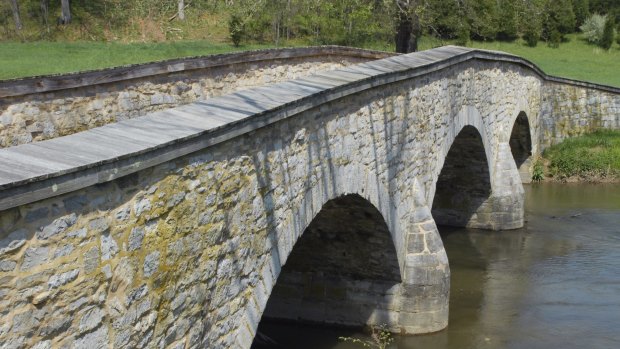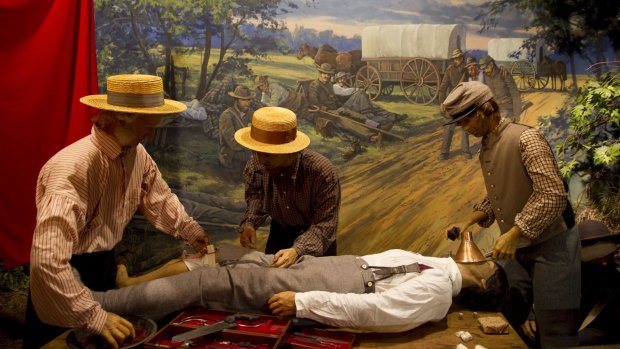This was published 9 years ago
National Museum of Civil War Medicine, Maryland, USA: The other address for Gettysburg
A Maryland museum reveals the horror and history of America’s Civil War, writes Paula Goodyer.
By Paula Goodyer

War relic: The guns are silent now at Monocacy National Battlefield, near Frederick.Credit: iStock
If you're keen on America's Civil War history, he sites of big battles like Gettysburg and Antietam are obvious places to go. But when a battlefield reverts back to a peaceful green landscape it can't always evoke the awfulness of this war, its effect on people's lives – or how medicine coped with its terrible injuries. For that you need the National Museum of Civil War Medicine in the pretty town of Frederick, Maryland.
It was 150 years ago that Confederate General Jubal Early rode into Frederick and demanded a ransom of $200,000 – his price for not burning the town down. The banks paid up and the legacy is all around in streets lined with beautifully preserved 18th and 19th century buildings, including the one housing this unique museum.
Among the displays of 19th-century medication, prosthetic arms and legs and surgical instruments are the poignant memories of the people who lived through this war, like Henrietta Jaquette, a Civil War nurse who wrote to her cousin in 1863:

The Burnside Bridge spanning Antietam Creek.Credit: iStock
"I do not mind the sight of blood, have seen limbs taken off and was not sick at all ... I would get on first rate if they would not ask me to write to their mothers – that I cannot do without crying which is not pleasant for either party."
But it's a fragment of skull displayed behind glass that really brings you undone. This isn't an anonymous scrap of bone: beside it is the story of the man it once belonged to, and how it came to be separated from his head. He was Charles Trainer, one of 23,000 men killed or wounded at the battle of Antietam, and this piece of his skull is part of an exhibit showing the effects of 19th-century warfare on human bone that's made deeply personal by the stories of the people who bore these injuries.
Trainer's head wound was caused by what was then the cutting edge of military technology: a new musket ball called a Minie ball that could make a bigger mess of human flesh than the standard ammunition of the time. Not only was it faster, it was also capable of splintering more bone, which in turn shredded more of the surrounding tissue. The damage done by the Minie ball – named after the French officer who invented it – led to a dramatic increase in infection and helps explain why three out of four operations carried out in the Civil War were amputations. Although Trainer was treated on the battlefield, it took 11 days to get him to a hospital. Paralysed, but "mentally unimpaired" by his wound, his injury had left part of his brain exposed. Surgeons removed the ball and bone fragments from his brain but after his discharge three months later an infection set in and he died.
It's a fragment of skull displayed behind glass that really brings you undone.
The building that houses this museum was never used as a hospital during the war – it was an undertaker's. But there's another museum nearby that was. The Seminary Ridge Museum at Gettysburg, 40 kilometres from Frederick, is a former Lutheran Seminary that became a makeshift hospital as 51,000 men were killed or wounded over three days of fighting at the Battle of Gettysburg in 1863. Part of what makes this museum experience so moving are the voices you hear as you walk from room to room – a reading of the recollections of Lydia and Hugh Ziegler who, as children, were living at the seminary when the battle broke out.
Like the stories of Henrietta Jaquette and Charles Trainer, their account of what happened brings the war to life more vividly than a walk around the battlefield of Gettysburg itself. As the seminary dormitories overflowed with bleeding men, both children helped care for the injured, often running up and down stairs to fetch water. A pail filled with water sits on the same stairs today with a sign inviting you to pick it up and feel how heavy it is. It's heavy.
Most moving of all is 12-year-old Lydia's memory of helping an old couple who'd lost four of their five sons in the war and had walked 21 miles to Gettysburg to bring food to their remaining son Charlie.

A battlefield surgery scene as shown in the National Museum of Civil War Medicine.Credit: Rick Stevens Photography
"Charlie was found lying in one of the rooms of the third floor of the Seminary building in a dying condition," Lydia recalls. "The cries of that mother as she bent over the body of her boy were heartbreaking. For a short time consciousness returned to Charlie and he knew his parents, who shortly after had at least some measure of comfort in taking his body home for burial."
Close to Washington DC, the town of Frederick itself is rich in Civil War history and a good base for exploring other sites – it's only a short drive from the battlefields of Antietam and Gettysburg and close to Harper's Ferry in the beautiful Shenandoah Valley where abolitionist John Brown tried to start a slave insurrection in 1859, an event that helped trigger the Civil War.
Etihad Airways has return flights from Sydney and Melbourne to Washington DC from $2208.54. See etihad.com/en-au. Frederick is less than an hour's drive from Washington DC or about one and a half hours by MARC train from Washington Union Station.
STAYING THERE
Frederick has a wide range of hotels, motels and B&Bs, including Hollerstown Hill Bed and Breakfast; see hollerstownhill.com. Basic rates $145-$175 for a double room.
Sign up for the Traveller Deals newsletter
Get exclusive travel deals delivered straight to your inbox. Sign up now.